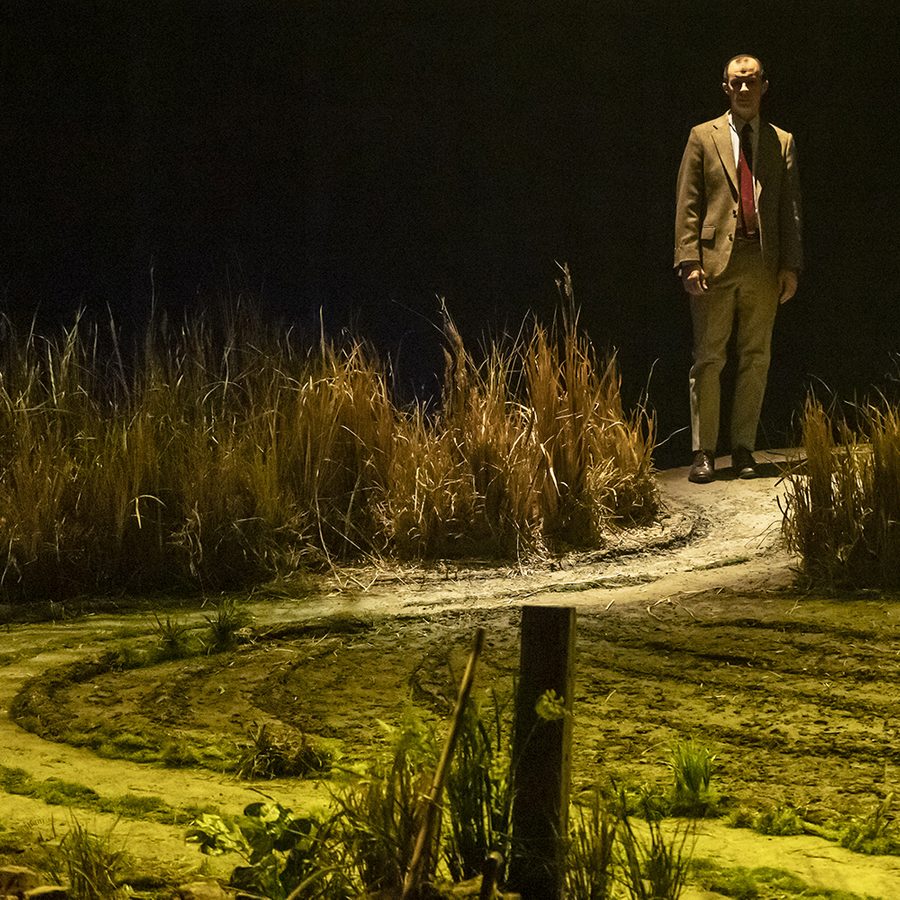
Our production team share what they learned from using sustainable production principles on our recent critically acclaimed production.
By Zara Janmohamed, Deputy Production Manager on Dancing at Lughnasa.
Since May 2021, we’ve been using principles from the Theatre Green Book to advise on how to make our productions more sustainable.
So, when it came time to transform Rob Jones’ wonderful set design for Dancing at Lughnasa into a lush Irish landscape that includes, fields, grassy areas, and a traditional dry-stone wall, our production team knew it was the perfect opportunity to put everything we’ve learned so far into practice.
All the teams involved were asked to look at ways to reduce, reuse and recycle materials from past shows and our stores to bring Josie Rourke and Rob Jones’ new production to life.
Floor cloths that had been used on five previous shows were retextured and repainted to create an Irish landscape, while parts of the corn field were repurposed from ‘Three Sisters’.
Instead of making rostra we used our stock of steel deck to create our raked stage and the kitchen slate floor was made from a new sustainable product, which is made from agricultural waste and is biodegradable, which we are trying to use across our projects.
Over 50% of the props and set dressing were sourced from our stores or are repurposed secondhand items.
Given that the play is set in rural Ireland meant that the costume department wanted to use as much original clothing as possible.
Our costume hire store offers us considerable choices and range; however, we are restricted on how much stock we can keep due to the size of the costume store. In addition to our stock, we have hired from external sources at a cost which is well below the cost of making the items. For this show; 80% of costumes were vintage stock with the other 20% of items that we could not locate, were either made or bought for the production and 90% of the shoes are from our shoe stock or hired.
Inevitably, as the original clothes are over 80 years old, they often will need repairing and considerable upkeep during the run of the play. At the end of the show 90% of costumes for this show have a future use on other productions.
Other items bought for the show such as the grass and string curtains will have a future life and you will probably see the floor cloths on a stage in another guise in the future!
But then we hit a wall…literally!
The dry-stone wall build was a completely new element for the team, as normally we would use materials like polystyrene to carve out this shape and then paint it. However, we no longer use new polystyrene as it is so harmful to the environment.
Instead, we researched what other options there might be. First, we looked to see if any theatres were getting rid of something similar that we might be able to repurpose. Then, we looked at other materials that might be a good replacement for polystyrene, but nothing is available on the market yet. We finally settled on the idea of building it using real stone.
We brought in a specialist, stone waller – Jed Baxter. He was able to advise on the process of constructing a dry-stone wall, the materials we would need, and the potential pitfalls of building one on a raked hard-floor stage, rather than in a grassy field.
He was able to direct us to the reclaimed stone wall farm where we sourced our stone and advise on the quantity needed, before coming in for a day to build the wall on the Olivier Stage.
We started out looking at the design and how to remove the rake from the stage section that had the stone wall. (After all, we couldn’t risk having a wonky wall that falls over during the show!) We also needed to find a suitable base layer to go underneath the stones as a we were building onto a steel and timber frame, rather than a bed of soil.
Working with actual stone was slightly different than working with a traditional man-made stage material, as we were working with a natural surface. There were some real unknowns on how to find the best way to blend them into the existing set.
Overall we’re thrilled with how it’s turned out, and we can’t thank Jed enough for the advice and expertise he provided, to help us portray the Irish countryside on the Olivier stage.
Once the show finishes it’s run, we will be returning any suitable stones back to the reclamation farm so that they can be sent back out to build more stone walls – ensuring everything has a future life, and nothing is wasted.
As an organisation, we’re committed to reducing our carbon impact, and have set ourselves ambitious targets to achieve carbon neutrality by 2030.
Reusing and recycling are at the heart of this commitment and the baseline standard of the Theatre Green Book, with 50% of materials needing to have had a previous life, and 65% needing to be repurposed or recycled at the end. We’re also calculating the carbon footprint of every new item or material, including deliveries, and reducing the use of harmful chemicals.
This new approach means making these kinds of sustainable decisions part of the creative choices on our shows. It’s an enormous team effort, which needs every single person working on a show to rethink what they do. Every decision counts.
We aren’t experts yet, but we will be. Everything we learn along the way will help us change the way we make theatre for good and help our planet.



